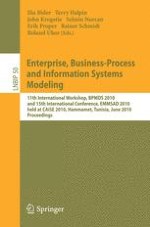This book contains the proceedings of two well established scienti?c events held in connection with the CAiSE conferences relating to the areas of enterprise, business-processes, and information systems modeling: – The 11th International Workshop on Business Process Modeling, Devel- ment and Support (BPMDS 2010); – The 15th International Conference on Exploring Modeling Methods for S- tems Analysis and Design (EMMSAD 2010). The two events are introduced brie?y below. BPMDS 2010 BPMDS 2010wasthe 11th in a seriesof workshopsthat havesuccessfully served as a forum for raising and discussing new ideas in the area of business process development and support. The BPMDS series has produced 10 workshops from 1998 to 2009. Eight of these workshops, including the last seven (BPMDS 2003–BPMDS 2009) were held in conjunction with CAiSE conferences. The BPMDS workshops focus on topics relating to IT support for business processes, which addresses key issues that are relevant to the continuous development of information systems theory. The continued interest in these topics within the industrial and academic IS communities is re?ected by the success of the last BPMDS workshops and the emergence of new conferences devoted to this theme. Previous BPMDS workshops focused on the di?erent phases in the business processlife-cycleaswellasthedriversthatmotivateandinitiatebusinessprocess design and evolution.
